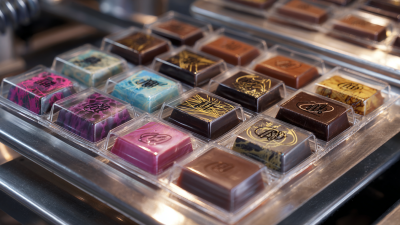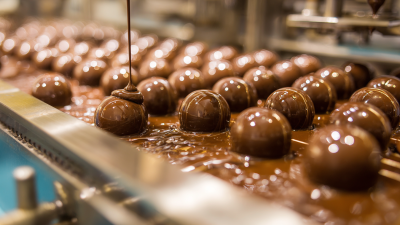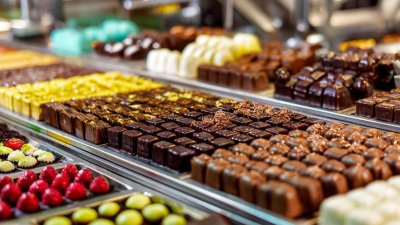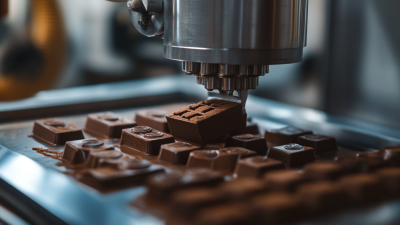Unleashing the Power of Chocolate Enrobing Machines in Modern Confectionery Production
In the ever-evolving landscape of confectionery production, chocolate enrobing machines have emerged as a game-changer, revolutionizing the way chocolate products are manufactured and enhancing overall production efficiency. According to a recent report by Technavio, the global chocolate market is expected to grow by USD 32 billion from 2022 to 2026, driven largely by an increasing demand for premium chocolate products. As manufacturers seek to capitalize on this growth, the integration of advanced chocolate enrobing machines facilitates not only the consistent coating of confections but also the scalability required to meet rising consumer demands. These machines allow for improved chocolate retention, reduced labor costs, and enhanced product quality, making them an essential investment for modern confectionery businesses. As the industry continues to innovate, understanding the capabilities and advantages of chocolate enrobing machines will be crucial for companies aiming to maintain a competitive edge in the marketplace.

The Rise of Chocolate Enrobing Machines in Confectionery Manufacturing
The rise of chocolate enrobing machines in confectionery manufacturing reflects a significant shift in production efficiency and product quality. According to a recent report by Grand View Research, the global chocolate market is expected to reach $162.49 billion by 2025, fueling demand for advanced manufacturing technologies. Chocolate enrobing machines play a pivotal role in this growth, allowing for uniform coating and enhanced presentation of confections. By automating the enrobing process, manufacturers can increase output and reduce labor costs, critical factors in a highly competitive market.
Furthermore, the adoption of these machines has led to innovative product development. Market research indicates that around 30% of confectionery producers are now incorporating enrobing technology to diversify their product lines. This enables them to experiment with various flavors, textures, and coatings, catering to changing consumer preferences. As health-conscious choices and specialty chocolates become more prominent, enrobing machines allow manufacturers to efficiently create indulgent offerings that can appeal to niche markets while maintaining consistent quality. Ultimately, the integration of chocolate enrobing technology is revolutionizing the confectionery industry, positioning manufacturers to better meet the demands of modern consumers.
Unleashing the Power of Chocolate Enrobing Machines in Modern Confectionery Production
Key Advantages of Automated Chocolate Coating in Production Efficiency
The modern confectionery industry is increasingly turning to automated chocolate enrobing machines to enhance production efficiency. According to a report by MarketsandMarkets, the global chocolate coating market is expected to grow at a CAGR of 4.2% from 2021 to 2026, indicating a robust demand for efficient production methods. Automated chocolate coating not only boosts output but also ensures uniformity and quality, which are critical in meeting consumer expectations. With machine enrobing, companies can coat products at high speeds—up to 1,500 kg per hour—far exceeding manual processes.
When integrating chocolate enrobing machines, it’s essential to consider the following tips: First, invest in machines that offer adjustable settings for coating thickness to cater to different product requirements. Second, routine maintenance of these machines is crucial to avoid downtimes and ensure consistent performance. Lastly, training staff on proper machine operation can lead to a significant reduction in waste and an increase in overall product quality.
Moreover, the automation of chocolate coating processes significantly reduces labor costs and minimizes the risk of human error. Reports indicate that companies utilizing automated systems can see a production efficiency increase of up to 30%, allowing for quicker scaling to meet growing demand without compromising on quality or taste. This evolution in chocolate production not only enhances profitability but also positions businesses to compete effectively in a dynamic market.
Impact of Chocolate Enrobing on Product Quality and Consistency
Chocolate enrobing machines have revolutionized modern confectionery production by significantly enhancing product quality and consistency. According to a report by Research and Markets, the global chocolate processing market is projected to reach $50.9 billion by 2025, illustrating the growing demand for high-quality chocolate products. Enrobing not only provides a visually appealing finish but also creates a protective layer that enhances shelf life and preserves the texture of the confectionery. This process allows manufacturers to maintain uniformity across batches, ensuring that each piece delivers the same delightful experience to consumers.

Moreover, the precision of chocolate enrobing machines plays a critical role in achieving consistent product quality. A study published by the International Journal of Food Science and Technology highlighted that automated enrobing can improve the weight consistency of chocolate-covered products by up to 30%. This level of accuracy minimizes product waste and maximizes profitability for manufacturers. As consumer preferences shift towards premium chocolate offerings, the ability to deliver consistent quality becomes essential, making chocolate enrobing machines indispensable in today's confectionery landscape.
Market Trends: Growth Projections for Chocolate Enrobing Technology in the Next Decade
In recent years, the chocolate enrobing technology has seen significant advancements, positioning itself as a pivotal component in the modern confectionery industry. The growing consumer demand for high-quality, artisanal chocolates has propelled manufacturers to invest in state-of-the-art enrobing machines. These machines not only enhance the aesthetic appeal of chocolate products but also improve production efficiency and consistency, allowing confectioners to scale their operations without compromising on quality.
Looking ahead, market projections indicate a robust growth trajectory for chocolate enrobing technology over the next decade. With an increasing focus on innovative flavors and unique product offerings, companies are expected to adopt more sophisticated enrobing solutions. This trend is driven by the rising consumer awareness about quality and the growing preference for premium confectionery products. As manufacturers seek to stay ahead of the competition, investments in advanced chocolate enrobing machinery are likely to play a crucial role in ensuring product excellence and meeting the evolving tastes of consumers.
Unleashing the Power of Chocolate Enrobing Machines in Modern Confectionery Production - Market Trends: Growth Projections for Chocolate Enrobing Technology in the Next Decade
| Year | Market Size (Million USD) | Growth Rate (%) | Key Drivers |
|---|---|---|---|
| 2024 | 150 | 5.0 | Increased demand for artisanal chocolates |
| 2025 | 158 | 5.3 | Growing popularity of vegan chocolates |
| 2026 | 167 | 5.7 | Innovation in flavor and texture |
| 2027 | 176 | 6.0 | Sustainability initiatives in sourcing |
| 2028 | 185 | 6.5 | Expanding retail channels |
| 2029 | 195 | 7.0 | Technological advancements in enrobing |
| 2030 | 205 | 7.5 | Increasing awareness of health benefits |
Integration of Innovative Technologies in Modern Chocolate Enrobing Processes
The integration of innovative technologies in modern chocolate enrobing processes has revolutionized the confectionery industry, enhancing production efficiency and product quality. Advanced automation systems streamline the enrobing process, allowing manufacturers to achieve consistent coating thickness and uniformity. These automated machines reduce labor costs and increase output, enabling producers to meet the rising consumer demand for chocolate products without sacrificing quality.

Furthermore, emerging technologies such as temperature control systems and real-time monitoring are critical in maintaining the integrity of chocolate during the enrobing process. By precisely regulating temperature and humidity, manufacturers can prevent the common issues of bloom and spoilage. Additionally, the use of robotics in positioning and packaging has enhanced the overall production workflow, minimizing human error and ensuring a more precise finish. This technological convergence not only boosts productivity but also opens avenues for developing unique product offerings that cater to diverse consumer preferences.
Related Posts
-

What are the Benefits of Investing in Chocolate Enrobing Machines for Global Manufacturers
-

Unlocking the Advantages of Best Chocolate Enrobing Machines for Your Production Line
-

Future Trends in Chocolate Enrobing Machines Market Analysis for 2025
-

How to Choose the Right Chocolate Enrobing Machine for Optimal Production Efficiency
-

Exploring the Technical Specifications of Chocolate Molding Machines and Tips for Optimal Production Efficiency
-

Maximizing Global Reach with Chocolate Enrobing Machines at the Record Breaking 137th Canton Fair